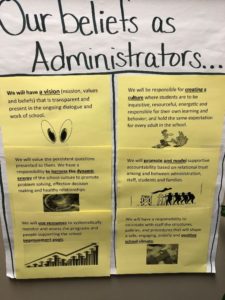Seven Defining Features of Odds-beating Secondary Schools
By Hal Lawson, NYKids Co-Investigator
Seven, thought to be a lucky number for gamblers, also designates pivotal improvement features in odds-beating secondary schools. Odds-beating educators constantly steward them, while benefiting from district central office leadership, guidance, supports, and resources.
This “lucky-7 combination” is an improvement resource for other educators. It provides a partial blueprint for their respective efforts to get better at getting better.
The seven features are:
1. Commitment
Odds-beating educators have a firm commitment to the young people in their care, and they will do whatever it takes to help them become college and career ready. “Whatever it takes” starts with academic learning and achievement, but it does not end there. Odds-beating educators know that adolescents need identity-related guidance, social-emotional supports, opportunities for non-academic engagement, and both college and career readiness planning. They relentlessly pursue multi-component strategies because they enable students to achieve the full range of desirable outcomes. Read about the commitment of Crown Point Central School to developing well-rounded young people.

2. Courage
Some of the innovative solutions needed for today’s secondary school students are not evident in state standards, prioritized in national educational policy, or disseminated in research briefs. Courageous, committed odds-beating educators must invent them! They are pioneers who extend the knowledge base for practice while holding firm on state-mandated standards. Read about the courageous practices taken by Sherburne-Earlville High School to connect with their community’s agricultural roots.
3. Connection
Like elaborate spider webs, odds-beating schools and their home districts are characterized by myriad connections among key stakeholders—students, teachers, student support professionals, principals, district central office leaders, parents, and committed community members. Positive school climates, i.e., today’s social-psychological atmosphere, are attributable to four connective clusters: (1) How educators treat and interact with other educators; (2) How educators treat and interact with students; (3) How students interact with each other and educators; and (4) How educators treat and interact with external constituencies, especially parents. Read more about how Maple Grove Junior/Senior High School connects with those inside and outside the school through listening and mutual respect.
4. Competence
Odds-beating educators’ commitments to innovate and improve depend on adult learning and professional development, necessitating a dual strategy. Therefore, they must give up practices that don’t work at the same time they adopt innovations and the new mindsets on which these innovations depend. Cultural competence with diverse learners is a prime example, and it extends to better ways to address poverty-related challenges. Read about how Alfred-Almond Junior-Senior High School fosters a learning environment to build competence among faculty.

5. Capacity
New educator competencies such as data-informed assessments and decision-making necessitate companion changes in schools-as-organizations. Odds-beating secondary schools are exemplars for capacity-building. For example, they have better data systems than typical schools, and they are characterized by new organizational routines. Just as organic gardens grow better plants, odds-beating schools’ new organizational gardens encourage and support optimal practices by educators and positive experiences for students. Read more about how data-informed systems build capacity and collaboration at Port Chester Senior High School.
6. Collaboration
A famous educational researcher popularized an essential research finding: Isolation is the enemy of improvement! Twin implications follow: No adult works alone, and no child is left to learn alone. Odds-beating schools are exemplars for both implications. Odds-beating educators organize in teams and communities of practice. In turn, they provide multiple opportunities for students to connect with each other, also ensuring that the adolescents in their care enjoy ready access to a caring, supportive adult—ideally a teacher, but extending to all adults in the school. Owing in part to such widespread collaboration, students and educators enjoy what researchers call “agency”. This means that adults and students alike enjoy voice and choice, which encourages their engagement and fosters resilience. Read more about how trust and collaboration are at the core of the work at Malverne Senior High School .
7. Conservation
Odds-beating educators relentless search for innovative solutions does not translate to an agenda named “out with the old, in with the new.” Nor does it mean reckless risk-taking, including hasty decisions regarding how best to use limited funding. In this light, odds-beating district central office and school leaders can be viewed as conservationists. They protect precious human and financial resources, investing them strategically and managing them wisely. Although prudent resource conservation and management often are hidden from the public eye, in odds-beating schools and districts they are hidden drivers for strategic innovation in tandem with enduring traditions that work. Read about the targeted investment in bilingual education made by Freeport High School.
